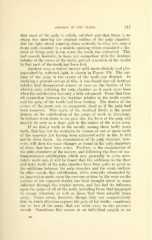Page 477 - My FlipBook
P. 477
ABRASION OF THE TEETH. 217
that most of the pulp is solidly calcified and that there is no
sharp line showing the original outline of the pulp chamber.
But the light streak running down centrally in what was once a
large pulp chamber is a minute opening which contained a fila-
ment of living pulp tissue when the tooth was extracted. This
had ceased, however, to have any connection with the dentinal
tubules of the crown of the tooth, and all sensation of the dentin
in that part of the tooth had been lost.
Another case, a central incisor split mesio-distally and pho-
tographed by reflected light, is shown in Figure 304. The out-
lines of the pulp in the crown of the tooth are distinct. In
stiidying a ground section of this, it was found that all dentinal
tubules had disaj^peared almost at once on the border of the
whitish area outlining the pulp chamber as it must have been
when the calcification was only a little advanced. From that time
all connection between the dentinal tubules in the tooth crown
and the pulp of the tooth had been broken. The dentin of the
crown of the tooth was as completely dead as if the pulp had
been removed. This death of the dentinal fibrils is the usual
history of the calcification of the pulps of teeth in abrasions.
In incisors worn down to the gvun line, the form of the pulp will
usually be seen as a clear spot in the center of the worn area.
If we find a tooth in the mouth, among these badly woi'n
teeth, that has lost its occlusion by reason of one or more teeth
of the opposite jaw having been extracted early in life, it will
not be worn down. An examination of its pulp chamber, how-
ever, will show the same changes as found in the pulp chambers
of those that have been worn. Further, in the examination of
the pulp chambers of the molars, and following the lines of con-
temporaneous calcification, which may generally be quite accu-
rately made out, it will be found that the additions to the floor
and axial walls of the pulp chamber have been quite as great as
the additions between the pulp chamber and the worn surface.
In other words, this calcification, while certainly stimulated by
an impression made upon the nervous system by the wear on the
surface of the exposed dentin, has been brought about by some
influence through the trophic nerves, and has had its influence
upon the pulps of all of the teeth, including those that happened
to escape abrasion, as well as those that were actually worn
away. Cases occur, however, though they are comparatively
few, in which abrasion exposes the pulp of the tooth ; sometimes
one or two of the many that are worn away in one person's
mouth. Sometimes this occurs in an individual cuspid, or an
3la


